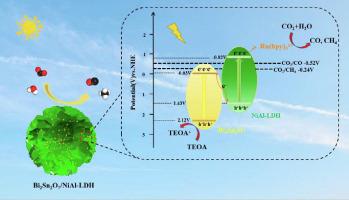Journal of Colloid and Interface Science ( IF 9.4 ) Pub Date : 2022-09-06 , DOI: 10.1016/j.jcis.2022.09.017 Shiming Zhang 1 , Yiyuan Rong 2 , Jingwen Wei 1 , Zhihong Li 1 , Ting Liang 1 , Zebin Yu 3 , Hongxiang Zhu 4 , Shuangfei Wang 5 , Yanping Hou 3

|
Fabrication of efficient photocatalysts with great visible light utilization ability, rapid carriers’ separation, and suitable redox potential is essential for improving photocatalytic CO2 reduction. Herein, flower-like microspheres Bi2Sn2O7/NiAl-layered double hydroxide (BSO/LDH) heterojunctions were prepared by hydrothermal process for CO2 reduction. The Bi2Sn2O7 nanoparticles were dispersed on NiAl-LDH nanosheets, with tight contact interface, which facilitated charges transfer and exposing more catalytic active sites. Results of photochemical deposition of metal/metal oxide demonstrated that interfacial charges transfer of the BSO/LDH followed Z-scheme mechanism, endowing more desired redox potential and more efficient carriers separation. The 30%-BSO/LDH showed the highest CO and CH4 yields of 37.91 and 1.18 μmol g−1 h−1 under visible light irradiation, 3.4 and 2.0 times higher than those from the NiAl-LDH, respectively. The main intermediates during CO2 reduction were carboxylate (COOH*) and aldehyde group (CHO*), and CO2 reduction pathways and mechanism were proposed accordingly. This study provided referential strategy for designing efficient heterojunction photocatalysts for CO2 conversion.
中文翻译:

花状微球Z型Bi2Sn2O7/NiAl-LDH异质结促进可见光光催化CO2还原
制备具有良好的可见光利用能力、快速的载流子分离和合适的氧化还原电位的高效光催化剂对于改善光催化CO 2还原至关重要。在此,通过水热法制备了花状微球Bi 2 Sn 2 O 7 /NiAl层状双氢氧化物(BSO/LDH)异质结,用于CO 2还原。Bi 2 Sn 2 O 7纳米粒子分散在NiAl-LDH纳米片上,具有紧密的接触界面,有利于电荷转移并暴露更多的催化活性位点。金属/金属氧化物的光化学沉积结果表明,BSO/LDH的界面电荷转移遵循Z-方案机制,赋予了更理想的氧化还原电位和更有效的载流子分离。在可见光照射下, 30%-BSO/LDH 的 CO 和 CH 4产率最高,分别为 37.91 和 1.18 μmol g -1 h -1,分别是 NiAl-LDH 的 3.4 倍和 2.0 倍。CO 2还原过程中的主要中间体是羧酸盐(COOH*)和醛基(CHO*),以及CO 2相应地提出了减排途径和机制。该研究为设计用于CO 2转化的高效异质结光催化剂提供了参考策略。











































 京公网安备 11010802027423号
京公网安备 11010802027423号